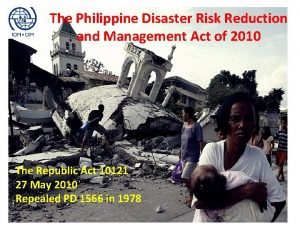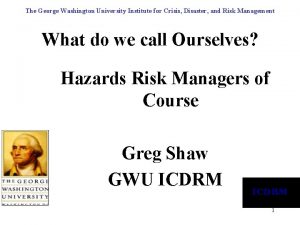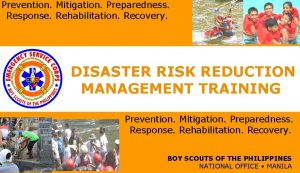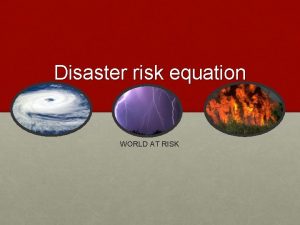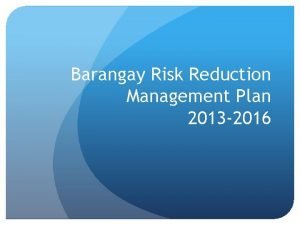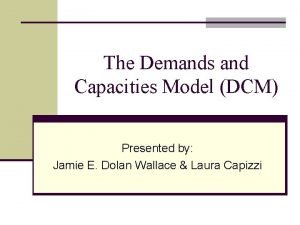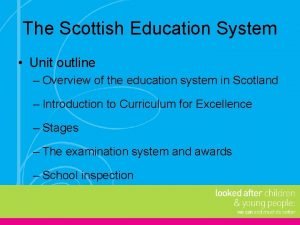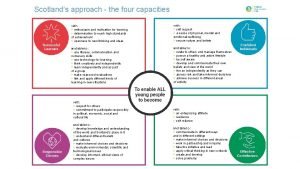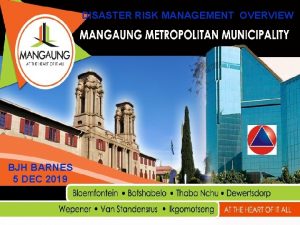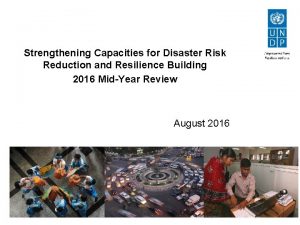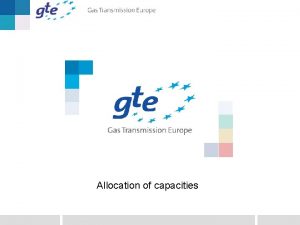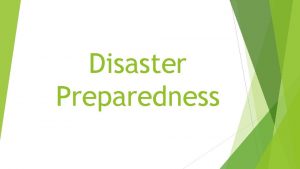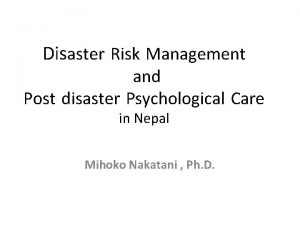DISASTER RISK MANAGEMENT Assessing and Leveraging Existing Capacities












- Slides: 12

DISASTER RISK MANAGEMENT: Assessing and Leveraging Existing Capacities Carl Bruch July 7, 2016 Sofia, Bulgaria

Overview • Assessment of Existing Capacities • Process • Institutions • Tools for Building Adaptive Capacity • Course on “Climate Change, Disasters, and Security” • Environmental Peacebuilding

Assessing Existing Capacities: Process • Two basic approaches • Supply • What are the relevant institutions? What capacities do they have? • Demand • What capacities are necessary? Which institutions might have those capacities? • Range of capacities • Prevention (inc. Planning), Mitigation, Preparedness, Response and Relief, and Recovery • Operational, policy, science/data • Participatory process • Think creatively • In assessing capacity, consider existing linkages • For dialogue, coordination, and cooperation

Assessing Existing Capacities: Institutions • International Actors • Regional Actors • National Actors • Other stakeholders

Assessing Existing Capacities: Institutions • International Actors • UN Agencies • Other International Organizations • Foreign militaries and aid agencies • Regional Actors • NATO, EU (including Monitoring and Information Centre (MIC) and Common Emergency Communication and Information System (CECIS)), etc. • National Actors • Military: Army, National Guard, Air Force • Civilian: Disaster Management Agencies, Planning Agencies, Environment Agencies, etc. • Other stakeholders • • Civil society Academia Private Sector (inc. Insurance) Local authorities

Civilian-Military Cooperation • Military assets and capabilities often essential to disaster response • Oslo Guidelines on the Use of Military and Civil Defense Assets in Disaster Relief • Basic framework formalizing and improving the effectiveness of military assets in disaster response • Core principles of humanity, neutrality, impartiality, and operational independence • Deference to civilian authority and risks of militarizing humanitarian assistance

Training on Climate Change, Disasters, and Security • Objective: Build capacity in African countries and partner organizations to develop wholeof-government approaches for natural disaster prevention and mitigation, preparedness, response, and recovery, focusing on disasters that are a consequence of or that are exacerbated by climate change. • Audience: African civil and military authorities, partner organizations, local and national emergency management agencies, civil society

Training on Climate Change, Disasters, and Security • Methodology: Presentations from international and national experts, interactive group exercises, case studies, field trip • Expected Outcomes: Participants will learn about linkages between disasters and security, and gain practical tools to improve prevention and mitigation, preparedness, response, and recovery to climaterelated natural disasters Exploring opportunities to adapt the course for other regions.

Environmental Peacebuilding The process of governing and managing natural resources and the environment to support durable peace. • Across the conflict lifecycle • efforts to prevent, mitigate, resolve, and recover from violent conflict • Involves • renewable natural resources (such as land, water, and fisheries) • non-renewable natural resources (such as minerals, oil, and gas) • ecosystems (including their services)

Environmental Dimensions in the Peace and Security Continuum Conflict Intensity Weapon of war Fueling and financing conflict Causing tensions and grievances al t en Incentive for peace spoiling Environmental Impacts En v rs e iv Dr iro nm Illegal exploitation and trade en ta nm o ir nv E Damaged by conflict ec Economic incentive for peacemaking and confidence building Entry point Employment for dialogue and livelihoods Revenues and basic services Good resource governance l. R ENVIRONMENTAL PEACEBUILDING Time ov e ry

Institutionalizing Environmental Peacebuilding Knowledge Platform (www. environmentalpeacebuilding. org) Environmental Peacebuilding Community of Practice (Google Group, Twitter, Linked. In, Facebook; > 2600 people) Environmental Peacebuilding Update (every 2 weeks) Environmental Peacebuilding Academy Annual lecture and award on environmental peacebuilding Communities of practice Operational guidance Massive open online course (MOOC) On the horizon: a peer-reviewed journal and an annual conference

Благодаря! Source: UNEP Carl Bruch bruch@eli. org
 Many new drivers first fender bender is a backing collision
Many new drivers first fender bender is a backing collision Module 4 topic 1 assessing and managing risk
Module 4 topic 1 assessing and managing risk In the new drm law, ndcc became
In the new drm law, ndcc became George washington crisis management
George washington crisis management Republic act 10121
Republic act 10121 Btec sport unit 3
Btec sport unit 3 Formula for disaster equation
Formula for disaster equation Bdrrm plan message
Bdrrm plan message Credit risk market risk operational risk
Credit risk market risk operational risk Demands and capacities model
Demands and capacities model Bronchial tree
Bronchial tree Cfe 4 capacities
Cfe 4 capacities Four capacities
Four capacities


